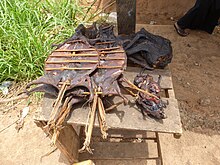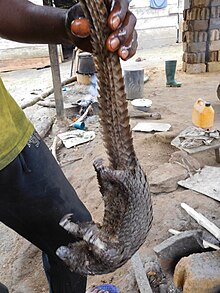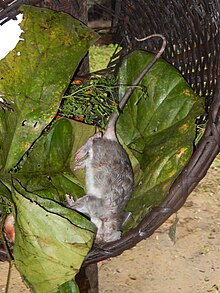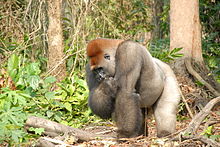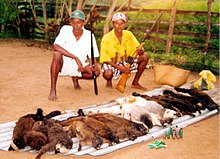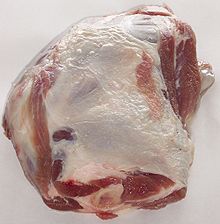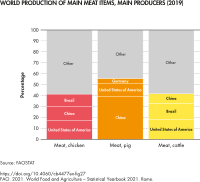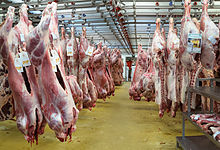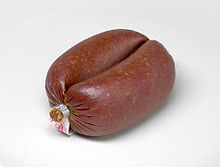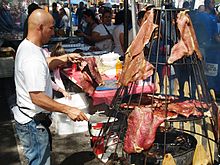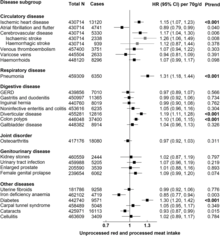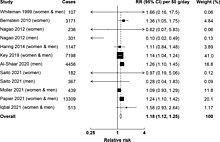From Wikipedia, the free encyclopedia
A selection of uncooked red meat and poultry
Meat is animal flesh that is eaten as food. Humans have hunted and killed animals for meat since prehistoric times. The advent of civilization allowed the domestication of animals
such as chickens, sheep, rabbits, pigs and cattle. This eventually led
to their use in meat production on an industrial scale with the aid of slaughterhouses.
Meat is mainly composed of water, protein, and fat.
It is edible raw, but is normally eaten after it has been cooked and
seasoned or processed in a variety of ways. Unprocessed meat will spoil or rot within hours or days as a result of infection with and decomposition by bacteria and fungi.
Meat is important to economies and cultures, but the production
and consumption of meat pose risks for human health, animal health, and
the environment. Vegetarians and vegans do not eat meat for reasons such as the ethics of eating meat, the environmental effects of meat production, the health effects of meat consumption, or religious dietary rules.
Terminology
The word meat comes from the Old English word mete, which referred to food in general. The term is related to mad in Danish, mat in Swedish and Norwegian, and matur in Icelandic and Faroese, which also mean 'food'. The word mete also exists in Old Frisian (and to a lesser extent, modern West Frisian) to denote important food, differentiating it from swiets (sweets) and dierfied (animal feed).
Most often, meat refers to skeletal muscle and associated fat and other tissues, but it may also describe other edible tissues such as offal. Meat is sometimes also used in a more restrictive sense to mean the flesh of mammalian species (pigs, cattle, lambs, etc.) raised and prepared for human consumption, to the exclusion of fish, other seafood, insects, poultry, or other animals.
In the context of food, meat can also refer to "the edible part of something as distinguished from its covering (such as a husk or shell)", for example, coconut meat.
In English, there are also specialized terms for the meat of particular animals. These terms originated with the Norman conquest of England
in 1066: while the animals retained their English names, their meat as
brought to the tables of the invaders was referred to them with the Norman French words for the respective animal. In time, these appellations came to be used by the entire population.
History
Hunting and farming
Paleontological evidence suggests that meat constituted a substantial proportion of the diet of the earliest humans. Early hunter-gatherers depended on the organized hunting of large animals such as bison and deer.
The domestication of animals, of which we have evidence dating back to the end of the last glacial period (c. 10,000 BCE), allowed the systematic production of meat and the breeding of animals with a view to improving meat production. Animals that are now principal sources of meat were domesticated in conjunction with the development of early civilizations:
A typical shoulder cut of
lamb- Sheep, originating from western Asia, were domesticated with the help of dogs prior to the establishment of settled agriculture, likely as early as the 8th millennium BCE. Several breeds of sheep were established in ancient Mesopotamia and Egypt by 3500–3000 BCE. Today, more than 200 sheep-breeds exist.
- Cattle were domesticated in Mesopotamia after settled agriculture was established about 5000 BCE, and several breeds were established by 2500 BCE. Modern domesticated cattle fall into the groups Bos taurus (European cattle) and Bos taurus indicus (zebu), both descended from the now-extinct aurochs. The breeding of beef cattle,
cattle optimized for meat production as opposed to animals best suited
for work or dairy purposes, began in the middle of the 18th century.
A
Hereford bull, a breed of cattle frequently used in beef production.
- Domestic pigs, which are descended from wild boars, are known to have existed about 2500 BCE in modern-day Hungary and in Troy; earlier pottery from Tell es-Sultan (Jericho) and Egypt depicts wild pigs. Pork sausages and hams were of great commercial importance in Greco-Roman times. Pigs continue to be bred intensively as they are being optimized to produce meat best suited for specific meat products.
Other animals are or have been raised or hunted for their flesh. The
type of meat consumed varies much between different cultures, changes
over time, depending on factors such as tradition and the availability
of the animals. The amount and kind of meat consumed also varies by
income, both between countries and within a given country.
- Deer are hunted for their meat (venison) in various regions.
- Horses are commonly eaten in France, Italy, Germany and Japan, among other countries. Horses and other large mammals such as reindeer were hunted during the late Paleolithic in western Europe.
- Dogs are consumed in China, South Korea and Vietnam. Dogs are also occasionally eaten in the Arctic regions. Historically, dog meat has been consumed in various parts of the world, such as Hawaii, Japan, Switzerland and Mexico.
- Cats are consumed in Southern China, Peru and sometimes also in Northern Italy.
- Guinea pigs are raised for their flesh in the Andes.
- Whales and dolphins are hunted, partly for their flesh, in Japan, Alaska, Siberia, Canada, the Faroe Islands, Greenland, Iceland, Saint Vincent and the Grenadines and by two small communities in Indonesia.
Modern agriculture employs a number of techniques, such as progeny testing, to speed artificial selection by breeding animals to rapidly acquire the qualities desired by meat producers. For instance, in the wake of well-publicised health concerns associated with saturated fats
in the 1980s, the fat content of United Kingdom beef, pork and lamb
fell from 20–26 percent to 4–8 percent within a few decades, due to both
selective breeding for leanness and changed methods of butchery. Methods of genetic engineering aimed at improving the meat production qualities of animals are now also becoming available.
Even though it is a very old industry, meat production continues to
be shaped strongly by the evolving demands of customers. The trend
towards selling meat in pre-packaged cuts has increased the demand for
larger breeds of cattle, which are better suited to producing such cuts.
Even more animals not previously exploited for their meat are now being
farmed, especially the more agile and mobile species, whose muscles
tend to be developed better than those of cattle, sheep or pigs. Examples are the various antelope species, the zebra, water buffalo and camel, as well as non-mammals, such as the crocodile, emu and ostrich. Another important trend in contemporary meat production is organic farming which, while providing no organoleptic benefit to meat so produced, meets an increasing demand for organic meat.
Culture
For most of human history, meat was a largely unquestioned part of the human diet. Only in the 20th century did it begin to become a topic of discourse and contention in society, politics and wider culture.
Consumption
Number of Land Animals Killed for Meat in 2013
| Animals
|
Number Killed
|
| Chickens
|
61,171,973,510
|
| Ducks
|
2,887,594,480
|
| Pigs
|
1,451,856,889
|
| Rabbits
|
1,171,578,000
|
| Geese
|
687,147,000
|
| Turkeys
|
618,086,890
|
| Sheep
|
536,742,256
|
| Goats
|
438,320,370
|
| Cattle
|
298,799,160
|
| Rodents
|
70,371,000
|
| Pigeons and other birds
|
59,656,000
|
| Buffalo
|
25,798,819
|
| Horses
|
4,863,367
|
| Donkeys and mules
|
3,478,300
|
| Camels and other camelids
|
3,298,266
|
Meat consumption varies worldwide, depending on cultural or religious preferences, as well as economic conditions. Vegetarians and vegans
choose not to eat meat because of ethical, economic, environmental,
religious or health concerns that are associated with meat production
and consumption.
While meat consumption in most industrialized countries is at high, stable levels...
... meat consumption in emerging economies is on the rise.
According to the analysis of the FAO the overall consumption for white meat
between 1990 and 2009 has dramatically increased. Poultry meat has
increased by 76.6% per kilo per capita and pig meat by 19.7%. Bovine
meat has decreased from 10.4 kg (22 lb 15 oz) per capita in 1990 to
9.6 kg (21 lb 3 oz) per capita in 2009.
Overall, diets that include meat are the most common worldwide according to the results of a 2018 Ipsos MORI study of 16–64 years olds in 28 different countries. Ipsos states “An
omnivorous diet is the most common diet globally, with non-meat diets
(which can include fish) followed by over a tenth of the global
population.” Approximately 87% of people include meat in their diet
in some frequency. 73% of meat eaters included it in their diet
regularly and 14% consumed meat only occasionally or infrequently.
Estimates of the non-meat diets were also broken down. About 3% of
people followed vegan diets; where consumption of meat, eggs, and dairy
are abstained from. About 5% of people followed vegetarian diets; where
consumption of meat is abstained from, but egg and/or dairy consumption
is not strictly restricted. About 3% of people followed pescetarian
diets; where consumption of the meat of land animals is abstained from,
fish meat and other seafood is consumed, and egg and/or dairy
consumption may or may not be strictly restricted.
History
In the nineteenth century meat consumption in Britain was the highest
in Europe, exceeded only by that in British colonies. In the 1830s
consumption per head in Britain was about 75 pounds a year, rising to
130 pounds in 1912. In 1904 laborers were found to consume 87 pounds a
year while aristocrats ate 300 pounds. There were estimated to be
43,000 meat purveyor establishments in Britain in 1910, with "possibly
more money invested in the meat industry than in any other British
business" except the finance industry. The USA was a meat importing country by 1926.
Truncated lifespan as a result of intensive breeding allowed more
meat to be produced from fewer animals. The world cattle population was
about 600 million in 1929, with 700 million sheep and goats and 300
million pigs.
Animal growth and development
Agricultural science has identified several factors bearing on the growth and development of meat in animals.
Genetics
| Trait
|
Heritability
|
| Reproductive efficiency
|
2–10%
|
| Meat quality
|
15–30%
|
| Growth
|
20–40%
|
| Muscle/fat ratio
|
40–60%
|
Several economically important traits in meat animals are heritable
to some degree (see the adjacent table) and can thus be selected for by animal breeding. In cattle, certain growth features are controlled by recessive genes which have not so far been controlled, complicating breeding. One such trait is dwarfism; another is the doppelender or "double muscling" condition, which causes muscle hypertrophy and thereby increases the animal's commercial value. Genetic analysis continues to reveal the genetic mechanisms that control numerous aspects of the endocrine system and, through it, meat growth and quality.
Genetic engineering techniques can shorten breeding programs significantly because they allow for the identification and isolation of genes coding for desired traits, and for the reincorporation of these genes into the animal genome. To enable such manipulation, research is ongoing (as of 2006) to map the entire genome of sheep, cattle and pigs. Some research has already seen commercial application. For instance, a recombinant bacterium has been developed which improves the digestion of grass in the rumen of cattle, and some specific features of muscle fibres have been genetically altered.
Experimental reproductive cloning
of commercially important meat animals such as sheep, pig or cattle has
been successful. Multiple asexual reproduction of animals bearing
desirable traits is anticipated, although this is not yet practical on a commercial scale.
Environment
Heat regulation in livestock
is of great economic significance, because mammals attempt to maintain a
constant optimal body temperature. Low temperatures tend to prolong
animal development and high temperatures tend to retard it.
Depending on their size, body shape, and insulation through tissue and
fur, some animals have a relatively narrow zone of temperature tolerance
and others (e.g. cattle) a broad one. Static magnetic fields, for reasons still unknown, also retard animal development.
Nutrition
The quality and quantity of usable meat depends on the animal's plane of nutrition,
i.e., whether it is over- or underfed. Scientists disagree about how
exactly the plane of nutrition influences carcass composition.
The composition of the diet, especially the amount of protein provided, is also an important factor regulating animal growth. Ruminants, which may digest cellulose, are better adapted to poor-quality diets, but their ruminal microorganisms degrade high-quality protein if supplied in excess. Because producing high-quality protein animal feed is expensive (see also Environmental impact
below), several techniques are employed or experimented with to ensure
maximum utilization of protein. These include the treatment of feed with
formalin to protect amino acids during their passage through the rumen, the recycling of manure by feeding it back to cattle mixed with feed concentrates, or the partial conversion of petroleum hydrocarbons to protein through microbial action.
In plant feed, environmental factors influence the availability of crucial nutrients or micronutrients, a lack or excess of which can cause a great many ailments. In Australia, for instance, where the soil contains limited phosphate, cattle are being fed additional phosphate to increase the efficiency of beef production.
Also in Australia, cattle and sheep in certain areas were often found
losing their appetite and dying in the midst of rich pasture; this was
at length found to be a result of cobalt deficiency in the soil. Plant toxins are also a risk to grazing animals; for instance, sodium fluoroacetate, found in some African and Australian plants, kills by disrupting the cellular metabolism. Certain man-made pollutants such as methylmercury and some pesticide residues present a particular hazard due to their tendency to bioaccumulate in meat, potentially poisoning consumers.
Human intervention
Meat producers may seek to improve the fertility of female animals through the administration of gonadotrophic or ovulation-inducing hormones. In pig production, sow infertility is a common problem — possibly due to excessive fatness. No methods currently exist to augment the fertility of male animals. Artificial insemination
is now routinely used to produce animals of the best possible genetic
quality, and the efficiency of this method is improved through the
administration of hormones that synchronize the ovulation cycles within
groups of females.
Growth hormones, particularly anabolic agents such as steroids, are used in some countries to accelerate muscle growth in animals. This practice has given rise to the beef hormone controversy, an international trade dispute. It may also decrease the tenderness of meat, although research on this is inconclusive, and have other effects on the composition of the muscle flesh. Where castration is used to improve control over male animals, its side effects are also counteracted by the administration of hormones.
Sedatives may be administered to animals to counteract stress factors and increase weight gain. The feeding of antibiotics to certain animals has been shown to improve growth rates also. This practice is particularly prevalent in the USA, but has been banned in the EU, partly because it causes antimicrobial resistance in pathogenic microorganisms.
Biochemical composition
Numerous aspects of the biochemical composition of meat vary in
complex ways depending on the species, breed, sex, age, plane of
nutrition, training and exercise of the animal, as well as on the
anatomical location of the musculature involved.
Even between animals of the same litter and sex there are considerable
differences in such parameters as the percentage of intramuscular fat.
Main constituents
Adult mammalian muscle flesh consists of roughly 75 percent water, 19 percent protein, 2.5 percent intramuscular fat, 1.2 percent carbohydrates and 2.3 percent other soluble non-protein substances. These include nitrogenous compounds, such as amino acids, and inorganic substances such as minerals.
Muscle proteins are either soluble in water (sarcoplasmic proteins, about 11.5 percent of total muscle mass) or in concentrated salt solutions (myofibrillar proteins, about 5.5 percent of mass). There are several hundred sarcoplasmic proteins. Most of them – the glycolytic enzymes – are involved in the glycolytic pathway, i.e., the conversion of stored energy into muscle power. The two most abundant myofibrillar proteins, myosin and actin, are responsible for the muscle's overall structure. The remaining protein mass consists of connective tissue (collagen and elastin) as well as organelle tissue.
Fat in meat can be either adipose tissue, used by the animal to store energy and consisting of "true fats" (esters of glycerol with fatty acids), or intramuscular fat, which contains considerable quantities of phospholipids and of unsaponifiable constituents such as cholesterol.
Red and white
Blade steaks are an example of "red" meat
Meat can be broadly classified as "red" or "white" depending on the concentration of myoglobin in muscle fibre. When myoglobin is exposed to oxygen,
reddish oxymyoglobin develops, making myoglobin-rich meat appear red.
The redness of meat depends on species, animal age, and fibre type: Red meat contains more narrow muscle fibres that tend to operate over long periods without rest, while white meat contains more broad fibres that tend to work in short fast bursts.
Generally, the meat of adult mammals such as cows, sheep, and horses is considered red, while chicken and turkey breast meat is considered white.
Nutritional information
Typical nutritional content of
110 g (4 oz; 1⁄4 lb) of meat
| Source
|
Energy: kJ (kcal)
|
Protein
|
Carbs
|
Fat
|
| Fish
|
460–590 (110–140)
|
20–25 g
|
0 g
|
1–5 g
|
| Chicken breast
|
670 (160)
|
28 g
|
0 g
|
7 g
|
| Lamb
|
1,000 (250)
|
30 g
|
0 g
|
14 g
|
| Steak (beef top round)
|
880 (210)
|
36 g
|
0 g
|
7 g
|
| Steak (beef T-bone)
|
1,900 (450)
|
25 g
|
0 g
|
35 g
|
| Dog (various cuts)
|
1,100 (270)
|
20 g
|
0 g
|
22 g
|
| Horse (strip steak)
|
590 (140)
|
25 g
|
0 g
|
7 g
|
| Pork loin
|
1,010 (242)
|
14 g
|
0 g
|
30 g
|
| Rabbit (domesticated)
|
900 (215)
|
32 g
|
0 g
|
9 g
|
All muscle tissue is very high in protein, containing all of the essential amino acids, and in most cases is a good source of zinc, vitamin B12, selenium, phosphorus, niacin, vitamin B6, choline, riboflavin and iron. Several forms of meat are also high in vitamin K. Muscle tissue is very low in carbohydrates and does not contain dietary fiber. While taste quality may vary between meats, the proteins, vitamins, and minerals available from meats are generally consistent.
The fat content of meat can vary widely depending on the species and breed of animal, the way in which the animal was raised, including what it was fed, the anatomical part of the body, and the methods of butchering and cooking. Wild animals such as deer are typically leaner than farm animals, leading those concerned about fat content to choose game such as venison.
Decades of breeding meat animals for fatness is being reversed by
consumer demand for meat with less fat. The fatty deposits that exist
with the muscle fibers in meats soften meat when it is cooked and
improve the flavor through chemical changes initiated through heat that
allow the protein and fat molecules to interact. The fat, when cooked
with meat, also makes the meat seem juicier. The nutritional
contribution of the fat is mainly calories as opposed to protein. As fat
content rises, the meat's contribution to nutrition declines. In
addition, there is cholesterol
associated with fat surrounding the meat. The cholesterol is a lipid
associated with the kind of saturated fat found in meat. The increase in
meat consumption after 1960 is associated with, though not definitively
the cause of, significant imbalances of fat and cholesterol in the
human diet.
The table in this section compares the nutritional content of
several types of meat. While each kind of meat has about the same
content of protein and carbohydrates, there is a very wide range of fat
content.
Production
World production of meat, main items
World production of main meat items, main producers (2019)
From FAO's World Food and Agriculture – Statistical Yearbook 2021
Meat is produced by killing an animal and cutting flesh out of it. These procedures are called slaughter and butchery, respectively. There is ongoing research into producing meat in vitro; that is, outside of animals.
Transport
Upon reaching a predetermined age or weight, livestock are usually transported en masse
to the slaughterhouse. Depending on its length and circumstances, this
may exert stress and injuries on the animals, and some may die en route. Unnecessary stress in transport may adversely affect the quality of the meat. In particular, the muscles of stressed animals are low in water and glycogen, and their pH fails to attain acidic values, all of which results in poor meat quality. Consequently, and also due to campaigning by animal welfare
groups, laws and industry practices in several countries tend to become
more restrictive with respect to the duration and other circumstances
of livestock transports.
Slaughter
Animals are usually slaughtered by being first stunned and then exsanguinated
(bled out). Death results from the one or the other procedure,
depending on the methods employed. Stunning can be effected through asphyxiating the animals with carbon dioxide, shooting them with a gun or a captive bolt pistol, or shocking them with electric current. In most forms of ritual slaughter, stunning is not allowed.
Draining as much blood as possible from the carcass is necessary
because blood causes the meat to have an unappealing appearance and is a
breeding ground for microorganisms. The exsanguination is accomplished by severing the carotid artery and the jugular vein in cattle and sheep, and the anterior vena cava in pigs.
The act of slaughtering animals for meat, or of raising or
transporting animals for slaughter, may engender both psychological
stress and physical trauma in the people involved. Additionally, slaughterhouse workers are exposed to noise of between 76 and 100 dB from the screams of animals being killed. 80 dB is the threshold at which the wearing of ear protection is recommended.
Dressing and cutting
After exsanguination, the carcass is dressed; that is, the head, feet, hide (except hogs and some veal), excess fat, viscera and offal are removed, leaving only bones and edible muscle. Cattle and pig carcases, but not those
of sheep, are then split in half along the mid ventral axis, and the carcase is cut into wholesale pieces. The dressing and cutting sequence, long a province of manual labor, is progressively being fully automated.
Conditioning
Under hygienic conditions and without other treatment, meat can be
stored at above its freezing point (–1.5 °C) for about six weeks without
spoilage, during which time it undergoes an aging process that
increases its tenderness and flavor.
During the first day after death, glycolysis continues until the accumulation of lactic acid causes the pH to reach about 5.5. The remaining glycogen, about 18 g per kg, is believed to increase the water-holding capacity and tenderness of the flesh when cooked. Rigor mortis sets in a few hours after death as ATP is used up, causing actin and myosin to combine into rigid actomyosin and lowering the meat's water-holding capacity, causing it to lose water ("weep"). In muscles that enter rigor in a contracted position, actin and myosin filaments overlap and cross-bond, resulting in meat that is tough on cooking – hence again the need to prevent pre-slaughter stress in the animal.
Over time, the muscle proteins denature in varying degree, with the exception of the collagen and elastin of connective tissue, and rigor mortis resolves. Because of these changes, the meat is tender and pliable when cooked just after death or after the resolution of rigor, but tough when cooked during rigor. As the muscle pigment myoglobin denatures, its iron oxidates, which may cause a brown discoloration near the surface of the meat. Ongoing proteolysis also contributes to conditioning. Hypoxanthine,
a breakdown product of ATP, contributes to the meat's flavor and odor,
as do other products of the decomposition of muscle fat and protein.
Additives
When meat is industrially processed in preparation of consumption, it may be enriched with additives to protect or modify its flavor or color, to improve its tenderness, juiciness or cohesiveness, or to aid with its preservation. Meat additives include the following:
- Salt
is the most frequently used additive in meat processing. It imparts
flavor but also inhibits microbial growth, extends the product's shelf
life and helps emulsifying finely processed products, such as sausages. Ready-to-eat meat products normally contain about 1.5 to 2.5 percent salt. Salt water or similar substances may also be injected into poultry meat to improve the taste and increase the weight, in a process called plumping.
- Nitrite is used in curing meat to stabilize the meat's color and flavor, and inhibits the growth of spore-forming microorganisms such as C. botulinum. The use of nitrite's precursor nitrate is now limited to a few products such as dry sausage, prosciutto or parma ham.
- Phosphates used in meat processing are normally alkaline polyphosphates such as sodium tripolyphosphate.
They are used to increase the water-binding and emulsifying ability of
meat proteins, but also limit lipid oxidation and flavor loss, and
reduce microbial growth.
- Erythorbate or its equivalent ascorbic acid (vitamin C) is used to stabilize the color of cured meat.
- Sweeteners such as sugar or corn syrup impart a sweet flavor, bind water and assist surface browning during cooking in the Maillard reaction.
- Seasonings impart or modify flavor. They include spices or oleoresins extracted from them, herbs, vegetables and essential oils.
- Flavorings such as monosodium glutamate impart or strengthen a particular flavor.
- Tenderizers break down collagens to make the meat more palatable for consumption. They include proteolytic enzymes, acids, salt and phosphate.
- Dedicated antimicrobials include lactic, citric and acetic acid, sodium diacetate, acidified sodium chloride or calcium sulfate, cetylpyridinium chloride, activated lactoferrin, sodium or potassium lactate, or bacteriocins such as nisin.
- Antioxidants include a wide range of chemicals that limit lipid oxidation, which creates an undesirable "off flavor", in precooked meat products.
- Acidifiers,
most often lactic or citric acid, can impart a tangy or tart flavor
note, extend shelf-life, tenderize fresh meat or help with protein denaturation
and moisture release in dried meat. They substitute for the process of
natural fermentation that acidifies some meat products such as hard salami or prosciutto.
Misidentification
With the rise of complex supply chains, including cold chains,
in developed economies, the distance between the farmer or fisherman
and customer has grown, increasing the possibility for intentional and
unintentional misidentification of meat at various points in the supply
chain.
In 2013, reports emerged across Europe that products labelled as containing beef actually contained horse meat. In February 2013 a study was published showing that about one-third of raw fish are misidentified across the United States.
Imitation
Various forms of imitation meat
have been created for people who wish not to eat meat but still want to
taste its flavor and texture. Meat imitates are typically some form of
processed soybean (tofu, tempeh), but they can also be based on wheat gluten, pea protein isolate, or even fungi (quorn).
Environmental impact
Various environmental effects are associated with meat production.
Among these are greenhouse gas emissions, fossil energy use, water use,
water quality changes, and effects on grazed ecosystems.
The livestock sector may be the largest source of water pollution
(due to animal wastes, fertilizers, pesticides), and it contributes to
emergence of antibiotic resistance. It accounts for over 8% of global
human water use. It is a significant driver of biodiversity loss, as it causes deforestation, ocean dead zones, land degradation, pollution, and overfishing.
The occurrence, nature and significance of environmental effects varies among livestock production systems. Grazing of livestock can be beneficial for some wildlife species, but not for others. Targeted grazing of livestock is used as a food-producing alternative to herbicide use in some vegetation management.
Land use
Meat production is by far the biggest cause of land use, as it accounts for nearly 40% of the global land surface.
Just in the contiguous United States, 34% of its land area (265 million
hectares or 654 million acres) are used as pasture and rangeland,
mostly feeding livestock, not counting 158 million hectares (391 million
acres) of cropland (20%), some of which is used for producing feed for
livestock. Roughly 75% of deforested land around the globe is used for livestock pasture.
Climate change
The rising global consumption of carbon-intensive meat products has "exploded the global carbon footprint of agriculture," according to some top scientists. Meat production is responsible for 14.5% and possibly up to 51% of the world's anthropogenic greenhouse gas emissions.
Some nations show very different impacts to counterparts within the
same group, with Brazil and Australia having emissions over 200% higher
than the average of their respective income groups and driven by meat
consumption.
According to the Assessing the Environmental Impacts of Consumption and Production report produced by United Nations Environment Programme's
(UNEP) international panel for sustainable resource management, a
worldwide transition in the direction of a meat and dairy free diet is
indispensable if adverse global climate change were to be prevented. A 2019 report in The Lancet recommended that global meat (and sugar) consumption be reduced by 50 percent to mitigate climate change. Meat consumption in Western societies needs to be reduced by up to 90% according to a 2018 study published in Nature. The 2019 special report by the Intergovernmental Panel on Climate Change
advocated for significantly reducing meat consumption, particularly in
wealthy countries, in order to mitigate and adapt to climate change.
Biodiversity loss
Meat consumption is considered one of the primary contributors of the sixth mass extinction. A 2017 study by the World Wildlife Fund found that 60% of global biodiversity loss
is attributable to meat-based diets, in particular from the vast scale
of feed crop cultivation needed to rear tens of billions of farm animals
for human consumption puts an enormous strain on natural resources
resulting in a wide-scale loss of lands and species. Currently, livestock make up 60% of the biomass of all mammals on earth, followed by humans (36%) and wild mammals (4%). In November 2017, 15,364 world scientists signed a Warning to Humanity
calling for, among other things, drastically diminishing our per capita
consumption of meat and "dietary shifts towards mostly plant-based
foods". The 2019 Global Assessment Report on Biodiversity and Ecosystem Services, released by IPBES, also recommended reductions in meat consumption in order to mitigate biodiversity loss. A 2021 Chatham House
report asserted that a significant shift towards plant-based diets
would free up the land to allow for the restoration of ecosystems and
thriving biodiversity.
A July 2018 study in Science
says that meat consumption is set to rise as the human population
increases along with affluence, which will increase greenhouse gas
emissions and further reduce biodiversity.
Reducing environmental impact
The environmental impact of meat production can be reduced by conversion of human-inedible residues of food crops.
Manure from meat-producing livestock is used as fertilizer; it may be
composted before application to food crops. Substitution of animal
manures for synthetic fertilizers in crop production can be
environmentally significant, as between 43 and 88 MJ of fossil fuel
energy are used per kg of nitrogen in manufacture of synthetic
nitrogenous fertilizers.
Spoilage and preservation
The spoilage of meat occurs, if untreated, in a matter of hours or
days and results in the meat becoming unappetizing, poisonous or
infectious. Spoilage is caused by the practically unavoidable infection
and subsequent decomposition of meat by bacteria and fungi,
which are borne by the animal itself, by the people handling the meat,
and by their implements. Meat can be kept edible for a much longer time –
though not indefinitely – if proper hygiene is observed during production and processing, and if appropriate food safety, food preservation and food storage procedures are applied. Without the application of preservatives
and stabilizers, the fats in meat may also begin to rapidly decompose
after cooking or processing, leading to an objectionable taste known as warmed over flavor.
Methods of preparation
Fresh meat can be cooked for immediate consumption, or be processed, that is, treated for longer-term preservation
and later consumption, possibly after further preparation. Fresh meat
cuts or processed cuts may produce iridescence, commonly thought to be
due to spoilage but actually caused by structural coloration and diffraction of the light. A common additive to processed meats for both preservation and the prevention of discoloration is sodium nitrite. This substance is a source of health concerns because it may form carcinogenic nitrosamines when heated.
Meat is prepared in many ways, as steaks, in stews, fondue, or as dried meat like beef jerky. It may be ground then formed into patties (as hamburgers or croquettes), loaves, or sausages, or used in loose form (as in "sloppy joe" or Bolognese sauce).
Some meat is cured by smoking, which is the process of flavoring, cooking, or preserving food by exposing it to the smoke from burning or smoldering plant materials, most often wood. In Europe, alder is the traditional smoking wood, but oak is more often used now, and beech to a lesser extent. In North America, hickory, mesquite, oak, pecan, alder, maple, and fruit-tree woods are commonly used for smoking. Meat can also be cured by pickling, preserving in salt or brine (see salted meat and other curing methods). Other kinds of meat are marinated and barbecued, or simply boiled, roasted, or fried.
Meat is generally eaten cooked, but many recipes call for raw beef, veal or fish (tartare). Steak tartare is a meat dish made from finely chopped or minced raw beef or horse meat.
Meat is often spiced or seasoned, particularly with meat products such
as sausages. Meat dishes are usually described by their source (animal
and part of body) and method of preparation (e.g., a beef rib).
Meat is a typical base for making sandwiches. Popular varieties of sandwich meat include ham, pork, salami and other sausages, and beef, such as steak, roast beef, corned beef, pepperoni, and pastrami. Meat can also be molded or pressed (common for products that include offal, such as haggis and scrapple) and canned.
Health
There is concern and debate regarding the potential association of
meat, in particular red and processed meat, with a variety of health
risks. A study of 400,000 subjects conducted by the European Prospective Investigation into Cancer and Nutrition
and published in 2013 showed "a moderate positive association between
processed meat consumption and mortality, in particular due to
cardiovascular diseases, but also to cancer."
In 2015, the International Agency for Research on Cancer of the World Health Organization (WHO) classified processed meat as carcinogenic to humans (Group 1), based on "sufficient evidence in humans that the consumption of processed meat causes colorectal cancer." In the same year, the Agency classified red meat as probably (Group 2A) carcinogenic to humans.
A 1999 metastudy combined data from five studies from western countries. The metastudy reported mortality ratios, where lower numbers indicated fewer deaths, for fish
eaters to be 0.82, vegetarians to be 0.84, occasional meat eaters to be
0.84. Regular meat eaters and vegans shared the highest mortality ratio
of 1.00.
In response to changing prices as well as health concerns about saturated fat and cholesterol (see lipid hypothesis), consumers have altered their consumption of various meats. A USDA
report points out that consumption of beef in the United States between
1970–1974 and 1990–1994 dropped by 21%, while consumption of chicken increased by 90%.
During the same period of time, the price of chicken dropped by 14%
relative to the price of beef. From 1995–1996, beef consumption
increased due to higher supplies and lower prices.
The 2015–2020 Dietary Guidelines for Americans
asked men and teenage boys to increase their consumption of vegetables
or other underconsumed foods (fruits, whole grains, and dairy) while
reducing intake of protein foods (meats, poultry, and eggs) that they
currently overconsume.
Risk of 25 common conditions per >70g/day daily intake of unprocessed red and processed meat according to a study using
UK Biobank data.
The health effects of red meat are unclear as of 2019.
In 2021, a study of data on half a million U.K. citizens shows
associations between high levels of meat intake with risks of some of 25
common conditions including ischaemic heart disease and diabetes as well as a lower risk of iron deficiency anaemia.
A cohort study with over 130,000 participants published a few days
later, also found that a higher intake of processed meat was associated
with "a higher risk of mortality and major CVD". However, while some of the results did control for body mass index various other factors that were not controlled for may confound the associations and research of underlying mechanisms may be required for fully robust conclusions.
Contamination
Various toxic compounds can contaminate meat, including heavy metals, mycotoxins, pesticide residues, dioxins, polychlorinated biphenyl (PCBs). Processed, smoked and cooked meat may contain carcinogens such as polycyclic aromatic hydrocarbons.
Toxins may be introduced to meat as part of animal feed, as
veterinary drug residues, or during processing and cooking. Often, these
compounds can be metabolized in the body to form harmful by-products.
Negative effects depend on the individual genome, diet, and history of
the consumer. Any chemical's toxicity is also dependent on the dose and timing of exposure.
Cancer
There are concerns about a relationship between the consumption of meat, in particular processed and red meat, and increased cancer risk. The International Agency for Research on Cancer (IARC), a specialized agency of the World Health Organization (WHO), classified processed meat (e.g., bacon, ham, hot dogs, sausages) as, "carcinogenic to humans (Group 1), based on sufficient evidence in humans that the consumption of processed meat causes colorectal cancer." IARC also classified red meat as "probably carcinogenic to humans (Group 2A), based on limited evidence that the consumption of red meat causes cancer in humans and strong mechanistic evidence supporting a carcinogenic effect."
Heart disease
Risk of ischemic heart disease for each 50 g per day increase in processed meat consumption
The correlation of consumption to increased risk of heart disease is controversial. Some studies fail to find a link between red meat consumption and heart disease
(although the same study found statistically significant correlation
between the consumption of processed meat and coronary heart disease). A
large cohort study of Seventh-Day Adventists in California
found that the risk of heart disease is three times greater for
45-64-year-old men who eat meat daily, versus those who did not eat
meat. This study compared adventists to the general population and not
other Seventh Day Adventists who ate meat and did not specifically
distinguish red and processed meat in its assessment.
A major Harvard University study
in 2010 involving over one million people who ate meat found that only
processed meat had an adverse risk in relation to coronary heart
disease. The study suggests that eating 50 g (less than 2 ounces) of
processed meat per day increases risk of coronary heart disease by 42%,
and diabetes by 19%. Equivalent levels of fat, including saturated fats,
in unprocessed meat (even when eating twice as much per day) did not
show any deleterious effects, leading the researchers to suggest that
"differences in salt and preservatives, rather than fats, might explain
the higher risk of heart disease and diabetes seen with processed meats,
but not with unprocessed red meats."
A 2017 meta-analyses of randomized controlled trials
found that eating more than 0.5 servings of meat per-day does not
increase lipids, blood pressure, lipoproteins, or other heart disease
risk factors.
A scientific review
concluded that, except for poultry, at 50 g/day unprocessed red and
processed meat appear to be risk factors for ischemic heart disease,
increasing the risk by about 9 and 18 % respectively.
Obesity
Prospective analysis suggests that meat consumption is positively associated with weight gain in men and women. The National Cattlemen's Beef Association countered by stating that meat consumption may not be associated with fat gain.
In response, the authors of the original study controlled for just
abdominal fat across a sample of 91,214 people and found that even when
controlling for calories and lifestyle factors, meat consumption is
linked with obesity.
Additional studies and reviews have confirmed the finding that greater
meat consumption is positively linked with greater weight gain even when
controlling for calories, and lifestyle factors.
Bacterial contamination
Bacterial contamination has been seen with meat products. A 2011 study by the Translational Genomics Research Institute showed that nearly half (47%) of the meat and poultry in U.S. grocery stores were contaminated with S. aureus, with more than half (52%) of those bacteria resistant to antibiotics. A 2018 investigation by the Bureau of Investigative Journalism and The Guardian
found that around 15 percent of the US population suffers from
foodborne illnesses every year. The investigation also highlighted
unsanitary conditions in US-based meat plants, which included meat
products covered in excrement and abscesses "filled with pus".
Cooking
Meat can transmit certain diseases, but complete cooking and avoiding recontamination reduces this possibility.
Several studies published since 1990 indicate that cooking muscle meat creates heterocyclic amines
(HCAs), which are thought to increase cancer risk in humans.
Researchers at the National Cancer Institute published results of a
study which found that human subjects who ate beef rare or medium-rare
had less than one third the risk of stomach cancer than those who ate
beef medium-well or well-done. While eating muscle meat raw may be the only way to avoid HCAs fully, the National Cancer Institute states that cooking meat below 100 °C (212 °F) creates "negligible amounts" of HCAs. Also, microwaving meat before cooking may reduce HCAs by 90%.
Nitrosamines,
present in processed and cooked foods, have been noted as being
carcinogenic, being linked to colon cancer. Also, toxic compounds called
PAHs, or polycyclic aromatic hydrocarbons, present in processed, smoked and cooked foods, are known to be carcinogenic.
Sociology
Meat is part of the human diet in most cultures, where it often has symbolic meaning and important social functions. Some people choose not to eat meat (vegetarianism) or any food made from animals (veganism).
The reasons for not eating all or some meat may include ethical
objections to killing animals for food, health concerns, environmental
concerns or religious dietary laws.
Ethics
Ethical issues regarding the consumption of meat include objecting to the act of killing animals or to the agricultural practices used in meat production. Reasons for objecting to killing animals for consumption may include animal rights, environmental ethics, or an aversion to inflicting pain or harm on other sentient creatures.
Some people, while not vegetarians, refuse to eat the flesh of certain
animals (such as cows, pigs, cats, dogs, horses, or rabbits) due to
cultural or religious traditions.
Some people eat only the flesh of animals that they believe have
not been mistreated, and abstain from the flesh of animals raised in factory farms or else abstain from particular products, such as foie gras and veal.
Some techniques of intensive agriculture may be cruel to animals: foie gras is a food product made from the liver of ducks or geese that have been force fed
corn to fatten the organ; veal is criticised because the veal calves
may be highly restricted in movement, have unsuitable flooring, spend
their entire lives indoors, experience prolonged deprivation (sensory,
social, and exploratory), and be more susceptible to high amounts of
stress and disease.
Religious traditions
The religion of Jainism has always opposed eating meat, and there are also schools of Buddhism and Hinduism that condemn the eating of meat.
Jewish dietary rules (Kashrut) allow certain (kosher) meat and forbid other (treif). The rules include prohibitions on the consumption of unclean animals (such as pork, shellfish including mollusca and crustacea, and most insects), and mixtures of meat and milk.
Similar rules apply in Islamic dietary laws: The Quran
explicitly forbids meat from animals that die naturally, blood, the
meat of swine (porcine animals, pigs), and animals dedicated to other
than Allah (either undedicated or dedicated to idols) which are haram as opposed to halal.
Sikhism forbids meat of slowly slaughtered animals ("kutha") and prescribes killing animals with a single strike ("jhatka"), but some Sikh groups oppose eating any meat.
Psychology
Research in applied psychology has investigated practices of meat eating in relation to morality, emotions, cognition, and personality characteristics. Psychological research suggests meat eating is correlated with masculinity, support for social hierarchy, and reduced openness to experience. Research into the consumer psychology of meat is relevant both to meat industry marketing and to advocates of reduced meat consumption.
Gender
Unlike most other food, meat is not perceived as gender-neutral, and is particularly associated with men and masculinity. Sociological research, ranging from African tribal societies to contemporary barbecues, indicates that men are much more likely to participate in preparing meat than other food. This has been attributed to the influence of traditional male gender roles, in view of a "male familiarity with killing" (Goody) or roasting being more violent as opposed to boiling (Lévi-Strauss).
By and large, at least in modern societies, men also tend to consume
more meat than women, and men often prefer red meat whereas women tend
to prefer chicken and fish.
Philosophy
The founders of Western philosophy disagreed about the ethics of eating meat. Plato's Republic has Socrates describe the ideal state as vegetarian. Pythagoras believed that humans and animals were equal and therefore disapproved of meat consumption, as did Plutarch, whereas Zeno and Epicurus were vegetarian but allowed meat-eating in their philosophy. Conversely, Aristotle's Politics assert that animals, as inferior beings, exist to serve humans, including as food. Augustine drew on Aristotle to argue that the universe's natural hierarchy allows humans to eat animals, and animals to eat plants. Enlightenment philosophers were likewise divided. Descartes wrote that animals are merely animated machines, and Kant considered them inferior beings for lack of discernment; means rather than ends. But Voltaire and Rousseau disagreed. The latter argued that meat-eating is a social rather than a natural act, because children are not interested in meat.
Later philosophers examined the changing practices of eating meat in the modern age as part of a process of detachment from animals as living beings. Norbert Elias, for instance, noted that in medieval times cooked animals were brought to the table whole, but that since the Renaissance only the edible parts are served, which are no longer recognizably part of an animal. Modern eaters, according to Noëlie Vialles, demand an "ellipsis"
between meat and dead animals; for instance, calves' eyes are no longer
considered a delicacy as in the Middle Ages, but provoke disgust. Even in the English language, distinctions emerged between animals and their meat, such as between cattle and beef, pigs and pork. Fernand Braudel wrote that since the European diet of the 15th and 16th century was particularly heavy in meat, European colonialism
helped export meat-eating across the globe, as colonized peoples took
up the culinary habits of their colonizers, which they associated with
wealth and power.
